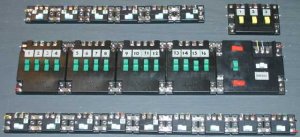I am having problems with my layout when hooking in an Atlas Controller (#220) to control a turntable.
According to the Atlas wiring book, the common rail needs to come of the controller "C" terminal. I did that and my trains do not operate. If I take the "C" off the two cabs (soldered together), the trains do operate but the controller needs to be in a specific (presumably off) position. I can then use the reverse switch on the cabs and the locos does reverse correctly.
Again, according to the Atlas book, when you do use a controller, you should not use the reverse switches on the cabs but rather the reverse sliders on the controller, one for Cab A and one for Cab B
It seems like I have some type of short or perhaps a faulty controller.
This is for my main line, where I guess I could avoid the controller entirely since it is just for the motor of the turntable. But when I get to my yard, I have 2 reversing sections, for which I believe I will need the controller. And hance even greater concern.
Anyone care to offer suggestions or tips?
Thanks
According to the Atlas wiring book, the common rail needs to come of the controller "C" terminal. I did that and my trains do not operate. If I take the "C" off the two cabs (soldered together), the trains do operate but the controller needs to be in a specific (presumably off) position. I can then use the reverse switch on the cabs and the locos does reverse correctly.
Again, according to the Atlas book, when you do use a controller, you should not use the reverse switches on the cabs but rather the reverse sliders on the controller, one for Cab A and one for Cab B
It seems like I have some type of short or perhaps a faulty controller.
This is for my main line, where I guess I could avoid the controller entirely since it is just for the motor of the turntable. But when I get to my yard, I have 2 reversing sections, for which I believe I will need the controller. And hance even greater concern.
Anyone care to offer suggestions or tips?
Thanks





